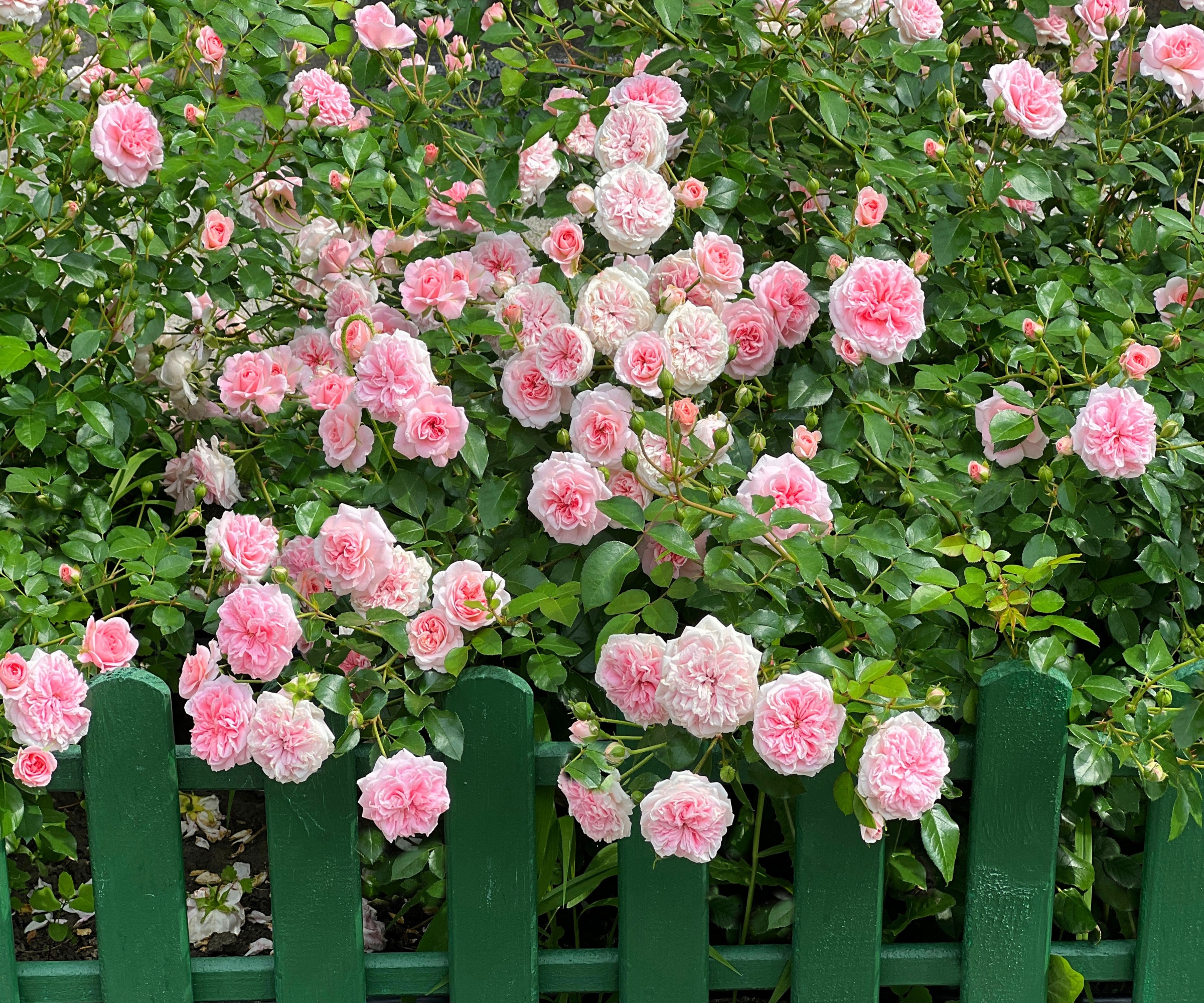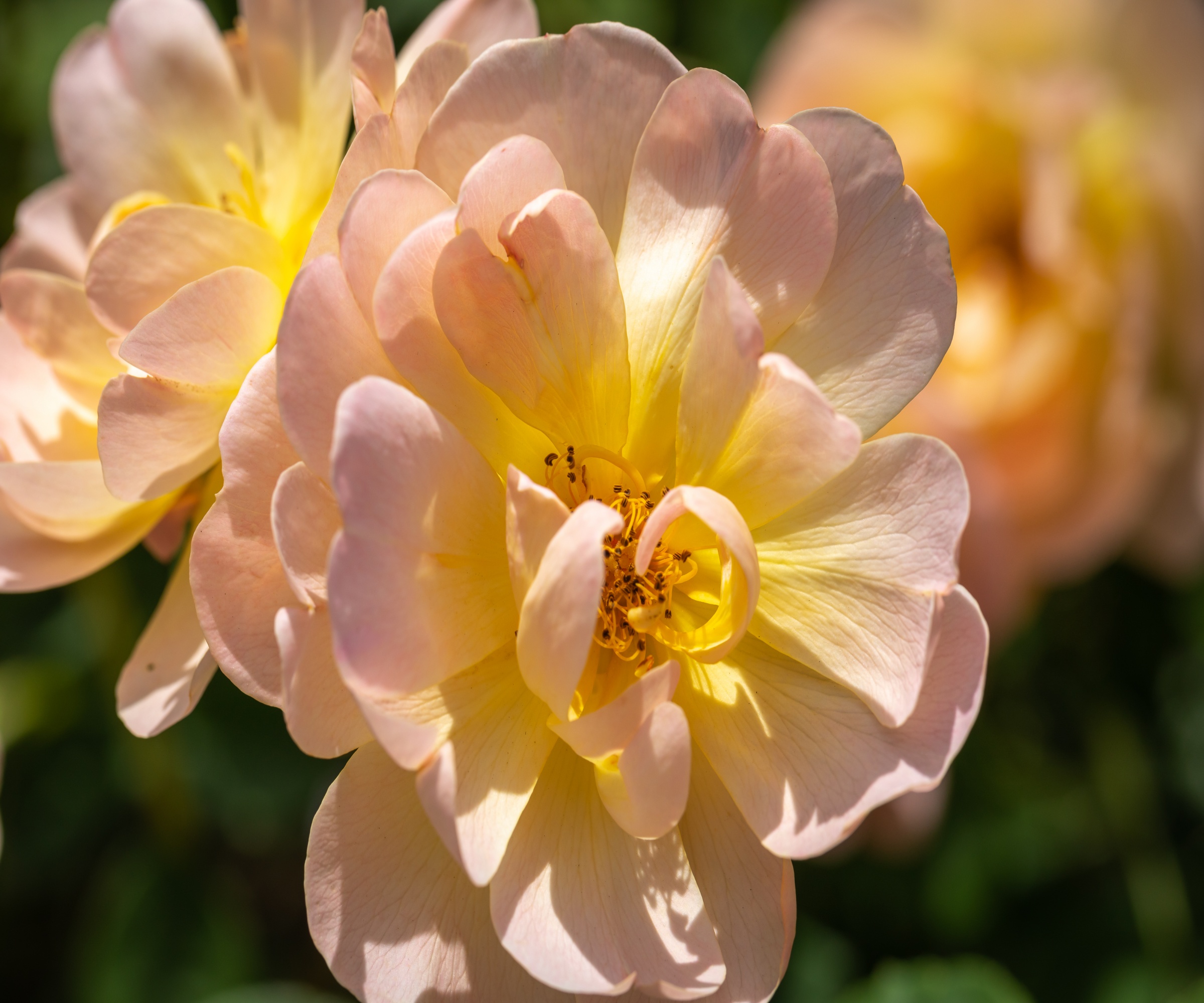
What I love about garden design is the ability we have to combine a practical aim with sheer beauty. A rose hedge is a perfect example of this. The best roses for hedging combine the prospect of privacy or a border with glorious, scented flowers, glossy leaves, and jewel-toned hips in the fall and winter.
As an added bonus, many varieties have wicked thorns meaning they make an excellent protective boundary for your backyard, while dwarf varieties can be used internally to divide your yard into different zones or outdoor rooms.
A few years ago we travelled to Spain, and every day we walked past a beautiful garden with a hedge of roses that filled the air with the sweetest rose perfume - it was an absolute feast for the senses. If you're thinking about landscaping with hedges, I've selected 10 of the best rose varieties that I know will thrive as hedge plants, providing beautiful borders as well as blooms.

How to choose the best hedge roses
Hedge roses usually come from varieties that are tough, more able to shrug off rose diseases and tolerant of harsh conditions, meaning they can be grown to USDA hardiness zone 2.
They can be part of your rose garden ideas, or a completely different planting scheme. These roses need relatively little care once established, but they will require some pruning to remove dead wood and thin, tangled stems.
Because of their density and thorns, hedge roses are also one of the best deer-resistant plants, creating a barrier that will deter even the most determined hind and stag.
Roses grow in a range of sizes, from dwarf shrub roses to sprawling ramblers and climbing roses, meaning there are appropriate hedge roses whatever size your yard.
1. Rosa ‘Gertrude Jeykll’

This is my number one personal choice because we have one growing in our front yard and it is one of the best climbing roses I’ve ever grown.
‘Gertrude Jekyll’ produces ruffled pink flowers with a strong, old fashioned rose scent and, best of all, if deadheaded and feed through the growing season it may bloom three times between early summer and mid-fall.
It will grow well in all soils and reaches a height of 4ft, and is suitable for zone 5, zone 6, zone 7, zone 8, zone 9 and zone 10.
Rose 'Gertrude Jekyll' is available to buy from Amazon.
2. Rosa ‘Lady of Shalott’

Named for the tragic heroine of Sir Alfred Lord Tennyson’s poem, this classic English rose has large orange blooms with over 60 petals apiece, producing a warm scent of cloves and apples that will bring the bees flocking.
It can reach a height and spread of 4ft and is happy in most soils, liking full sun and partial shade.
Despite her stunning looks, Rosa ‘Lady of Shalott’ is a relatively easy-going variety that can tolerate less-than-perfect soil and is suitable for hardiness zones 5-8.
Gallica rose varieties

Gallica roses are thought to be one of the oldest groups of roses and were originally grown by the Ancient Greeks and Romans. The Dutch started breeding new varieties in the 17th century and now we have a good selection for low-growing shrubs in shades of crimson, purple and mauve.
Perfect for the front of a rose hedge owing to its striking blooms, varieties include ‘Empress Josephine’, ‘Tuscany’, ‘Rosa Mundi’ and Rosa gallica ‘Oficinalis’.
These roses can be grown in hardiness zone 4 as well as zones 5-9.
4. Rosa ‘The Lark Ascending’

This is a disease-resistant rose variety with large cup-shaped blooms in an apricot shade. It has a light fragrance and grows to 5ft height and spread.
It is one of the few roses that will grow happily in a shaded spot and is also ideal for wildlife gardens, as it attracts pollinators and produces bright hips in the fall.
Suitable for growth in hardiness zone 5.
5. Rosa ‘Lady Banks’.

Rosa 'Lady Banks' is an evergreen rose with pale yellow flowers, though it originally produced white blooms.
Originally brought to the UK from China in 1807, its thornless stems can reach a length of 20ft, making it perfect for hedging, though it does like a sunny spot.
‘Lady Banks’ is low maintenance, needs little in the way of fertilizing or pruning, and as it is a relatively drought-tolerant rose it can survive reduced watering.
The largest specimen of this variety in the world is found in Arizona. It was planted in 1855 and now covers a colossal 8,000 sq ft! ‘Lady Banks’ will thrive in zones 6-8.
You can find'Lady Banks' rose plants at Walmart.
6. Polyantha rose varieties

Polyantha roses are compact shrubs that originate from an ancient climbing rose called R. multiflora 'Polyantha', which is one of the ancestors of modern-day floribunda roses.
It produces clusters of flowers at the top of each stem and is an incredibly sturdy variety, generally disease resistant and tolerant if tough conditions.
Good varieties include ‘Cecile Brunner’, which produces pink blooms. It is known as an ‘earth kind’ rose, as it needs little help from synthetic fertilizers and pesticides.
Another popular variety is the strongly scented ‘Perle d’or’, which has apricot-pink blooms, can handle heat and drought, and doesn’t need much in the way of feeding or pest control. Both are suitable for zone 5.
'Cecile Brunner' plants can be bought from Amazon.
7. Alba rose varieties

Alba roses date from the middle ages and their flowers are either white, pink or blush set off by elegant grey-green foliage. Popular varieties include ‘Queen of Denmark’, ‘Alba Maxima’ and ‘Amelia’.
This is an extremely hardy strain of roses, almost completely disease-free and able to thrive in the toughest conditions with little care. They can cope with light shade better than other rose varieties.
Suitable for zone 5, though some varieties can handle cold down to zone 3.
8. Rosa ‘Molineux’

Rosa 'Molineux' is a traditional English shrub rose that is suitable for all areas of the backyard, including containers, as well as being ideal as part of a rose hedge.
Rich yellow flowers are the calling card of this repeat-flowering beauty that can be grown in hardiness zone 5 and warmer.
'Molineux' can reach a height and spread of 3ft and has a light-to-medium tea musk scent. It is happy in all soil types and can handle partial shade.
9. China rose varieties

China roses, or Rosa Chinensis, are native to south west China. They grow into slender bushes with almost thornless stems bearing glossy foliage that is smaller than that of other rose varieties, and single or double flowers that appear reliably throughout the summer and fall.
The flowers of Rosa chinensis have a light, pleasant scent and the plants don’t need much pruning but they do like a sunny spot.
'Semperflorens', ‘Sophie’s Perpetual’ and ‘Old Blush’ are popular varieties, and they are suitable for growing in hardiness zones 6-9.
10. Species roses

If you are looking for horticultural heritage and history, then choose species roses for your hedge.
These are the forebears of all the roses we see on sale and growing today, and they are are a wide category of plants that produce beautifully simple, scented, open flowers in a variety of colors. Most of the blooms are single, and their scent attracts bees. In the fall they will decorate your hedge with a wealth of colorful hips to brighten the darker days.
Species roses range from rambling and climbing roses to shorter, denser shrub varieties and they are usually thorny, making them excellent for deterring intruders and deer. They are robust and need little pruning, though do remember that they flower on growth produced the previous year.
Popular varieties include the yellow ‘Canary bird’, the striking fire-hued Rosa foetida ‘Bicolor’, and the blood-red Rosa moyesii.
They grow best in zones 5-8.
How to care for a rose hedge

The best time to plant a rose hedge is the fall, when the soil is warm from the summer and dampened by seasonal rain, and the spring when soil is starting to warm up. Plant your roses closely together to create a dense barrier, no more than 18in apart if possible.
Hedge roses are usually robust and healthy and can withstand attacks by pests or disease. They develop deep root systems that lets them forage for food and moisture, though they will appreciate a feed with a general fertilizer in the spring.
Prune roses when plants are dormant in the fall and winter, removing old, dead and diseased growth and allowing good airflow around the plants to combat fungal diseases and allow maximum sunlight to encourage excellent blooming.
When you water, make sure the moisture hits the ground rather than the foliage and flowers to reduce the risk of fungal problems developing.
FAQs
Are ground cover roses worth considering for hedges?
Ground cover roses are fast-growing plants that hug the ground. They are ideal for drought-prone areas as their spreading habitat shades the soil and helps retain moisture, however, they are low growing and would not provide height or privacy as a traditional hedge would.
There are lots of varieties online including ‘Electric Blanket’, which has coral flowers, the pure white ‘Wedding Dress’ and ‘Beautiful Carpet’, which is a rich pink.
Take care when buying and read the labels carefully as some are more shrubby than ground covering and can compete with other plants.
Should I worry about pests on hedge roses?
Although many varieties if roses suitable for hedging are robust and disease-resistant, they will collect pests such as aphids. Don't worry though, as roses hedges also attract other insects and garden birds and many of these will prey on pests and help keep numbers in check. Rose hedges also offer food in the shape of hips in the fall, as well as secure places to roost and nest, so your rose hedge will benefit everyone.
A hedge of roses is guaranteed to bring beauty, scent and protection to your yard. It will also be a haven for garden birds and pollinators, and offer interest from late spring right through the fall and into winter if you leave its hips to develop. If wildlife gardening is high on your agenda, you might also be keen to read our picks of the best hedges for wildlife.







